|
Report from
Europe
Value of UK tropical wood product imports up 34%
The import value of tropical wood and wood furniture into
the UK in the opening five months of this year was
US$711 million, 34% more than the same period last year.
This was by far the strongest start to a year in terms of UK
import value of tropical wood and wood furniture products
since the 2008 financial crises (Chart 1). It compares to an
average import value of less than US$500 million for the
January to May period throughout the whole decade prior
to the onset of the pandemic in 2020.
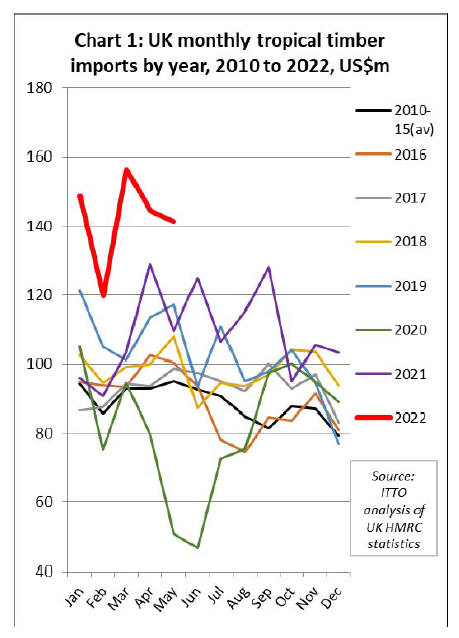
The rise in UK import quantity of tropical wood and wood
furniture was much less dramatic than the rise in import
value in the first five months of this year, at 228,000
tonnes just 10% more than the same period in 2021. This
shows that price inflation was the major factor behind the
rise in import value.
Significant weakening of the value of the GBP on foreign
exchange markets since the end of April, combined with
the wider geo-political situation, implies that price
inflation will remain a key issue for UK importers in the
months of ahead. It also indicates that the current boom in
UK imports may well be short-lived.
Availability of hardwood and furniture products from the
UK's traditionally largest suppliers in Europe has become
even more challenging since Russia's invasion of Ukraine
in the last week of February, encouraging UK importers to
look more to tropical products. COVID lockdowns have
also seriously disrupted availability of manufactured wood
products from China.
Tropical wood performs well compared to overall UK
market this year
Comparing tropical wood product imports with data for
total UK wood imports in the latest market statement from
Timber Development UK (TDUK formerly Timber Trade
Federation) implies that tropical products have performed
better than the overall UK timber market so far this year.
According to TDUK, the total volume of all timber
imported into the UK in Q1 2022 was 2.5 million m3,
nearly half a million m3 behind the record imports of Q1
2021. This decrease in total timber imports follows on
from a downward trend seen towards the back end of Q4
2021. TDUK note that ¡°While this downward trend may
have been sparked initially by market saturation for timber
products, loss of consumer and business confidence is now
the primary cause¡±.
TDUK highlight that while UK direct timber imports from
Russia are relatively low, demand for all timber products
in the UK is being impacted by the war in Ukraine through
its effects on consumer confidence, along with high energy
and material costs. The UK timber industry has responded
to the Russia-Ukraine conflict by following sanctions and
greatly reducing imports across all the main Russia import
categories.
In tonnage terms, comparing the first five months of 2022
with the same period last, UK imports of Russian
hardwood plywood were down 42% at 8,500 tonnes,
Russian softwood plywood was down 86% to just 250
tonnes, Russian softwood sawnwood was down 82% to
15,800 tonnes, Russian hardwood sawnwood was down
70% to 568 tonnes, and Russian softwood decking was
down 51% to 632 tonnes.
The large majority of UK wood product imports from
Russia this year arrived between January and March
(34,000 tonnes across all product categories). Less than
2,000 tonnes of Russian product were imported into the
UK in April and May.
Strong start to the year unlikely to be sustained in the
UK
TDUK¡¯s market statement highlights that UK demand for
timber was strong in the first quarter of this year,
particularly driven by construction output which reached a
record high during the period, just surpassing the previous
high set in Q1 2019. Drawing on data from the UK Office
of National Statistics (ONS), construction output was up
by 3.8% when comparing Q1 2021 with Q1 2022. The
private repair, maintenance and improvement (RM&I)
sector, which is particularly important for hardwoods, was
at historically high levels in the first quarter of this year.
However, TDUK note that the high level of demand in
unlikely to persist as the overall picture for the economy is
overwhelmingly negative across a range of
macroeconomic indicators.
The following adverse factors are identified by TDUK:
The stability of the construction sector¡¯s recovery
in 2022 has always remained subject to
inflationary pressures which at 9.1% as per the
Consumer Price Index in June, is now at its
highest rate in 40 years.
The Russia-Ukraine crisis leading to particularly
high energy and material costs.
Greater barriers to trade and a more complex
regulatory environment in the UK since Brexit.
The British pound has suffered severe
depreciation, plunging 10% this year according to
Bloomberg.
There is a ¡°cost of living crisis¡± with 88% of
British adults reporting an increase in their cost
of living in May 2022 according to ONS.
According to the GfK index, consumer
confidence in the UK was down 41 points in June
2022, the lowest since the index began in 1974.
Recent surveys indicate a decline in business
confidence.
The IMF now projects that global growth will
slow from 6.1% in 2021 to 3.6% in 2022 and
2023.
Political instability in the UK with Prime
Minister Boris Johnson deposed by his party in
July 2022.
Overall therefore, prospects for the rest of this year are far
from promising. This is reflected in the latest CPA
Construction Industry Forecasts released in July 2022
which predict that UK construction output will grow by
2.5% in 2022, a sharp revision down from just six months
ago of 4.3% growth.
Growth in 2023 has also been revised down to 1.6%, from
2.5%. The private RM&I sector is forecast to decline by
3.0% in 2022 and 4.0% in 2023 as it will be particularly
hard hit by inflation and falling consumer confidence.
Big increase in UK import value of wood furniture from
all main tropical suppliers
The UK imported US$374 million of tropical wood
furniture products in the first five months of 2022, which
is 28% more than the same period in 2021. In quantity
terms, wood furniture imports were 78,000 tonnes during
the five month period, 3% more than the same period last
year.
This indicates that the rise in value was driven more by
price inflation than strong demand. Import value increased
from all of the leading tropical supply countries to this
market in the first five months of this year compared to
last including Vietnam (+28% to US$182 million),
Malaysia (+6% to US$67 million), India (+47% to US$45
million), Indonesia (+53% to US$39 million), Singapore
(+2% to US$27 million), and Thailand (+25% to US$9
million) (Chart 2).

UK tropical wood import value up 49% in the first five
months of 2022
Total UK import value of all tropical wood products in
Chapter 44 of the Harmonised System (HS) of product
codes were US$337 million between January and May this
year, 49% more than the same period in 2021.
In quantity terms imports increased 14% to 150,000 tonnes
during the period. Compared to the first five months last
year, UK import value of tropical joinery products
increased 43% to US$140 million, import value of tropical
plywood was up 26% to US$85 million, import value of
tropical sawnwood increased 88% to US$57 million, and
import value of tropical mouldings/decking increased 65%
to US$16 million (Chart 3).
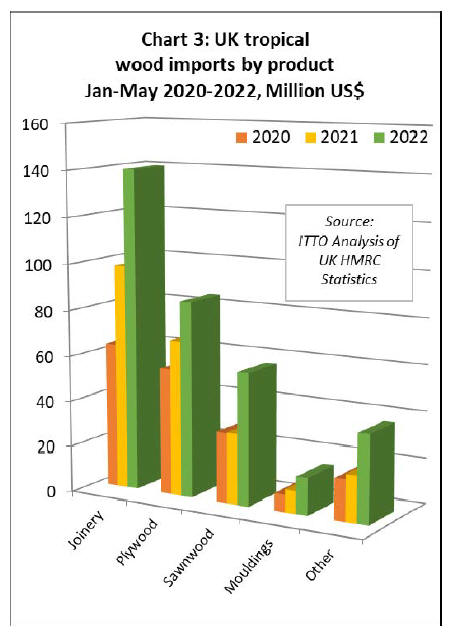
UK imports of wood doors from Indonesia gather
momentum
After the sharp dip in UK imports of tropical joinery
products during the first lockdown period in the second
quarter of 2020, imports of this commodity group have
progressively built momentum.
This trend is mainly driven by Indonesia for which UK
joinery imports, mainly consisting of doors, were US$77
million in the first five months this year, 37% more than
the same period in 2021 (Chart 4). In quantity terms, UK
joinery imports from Indonesia were 24,500 tonnes in the
first five months of this year, 11% more than the same
period in 2021.

UK imports of joinery products from Malaysia and
Vietnam (mainly laminated products for kitchen and
window applications) started this year more slowly.
Import value from Malaysia was US$18 million in the
January to May period, 26% less than the same period last
year. In quantity terms, imports from Malaysia were 5,800
tonnes, 37% less than the same period in 2021. Joinery
imports from Vietnam of 1100 tonnes valued at US$4
million were respectively 39% and 33% less than the same
period last year.
UK imports of Chinese tropical joinery products, nearly all
comprising doors, were 7,200 tonnes with value of US$19
million in the first five months of 2022, up from negligible
levels in previous years. Due to introduction from 1st
January 2022 of new product codes in the EU Combined
Nomenclature (still mirrored by the UK post-Brexit) it is
now possible to identify wood doors and windows
manufactured using a wider range of tropical wood species
in UK and EU trade statistics.
The apparent rise in imports of "tropical" wood joinery
from China is very likely due to these products now being
identifiable as of tropical species, whereas previously they
were classified as "other non-coniferous" in the trade
statistics and excluded from the figures for tropical wood
imports.
UK tropical hardwood plywood imports switch from
China to Indonesia
In the first five months of 2022, the UK imported 106,000
cu.m of tropical hardwood plywood, 18% less than the
same period last year. Tropical hardwood plywood
imports from Indonesia have made gains this year, while
imports from China have continued to slide (Chart 5).
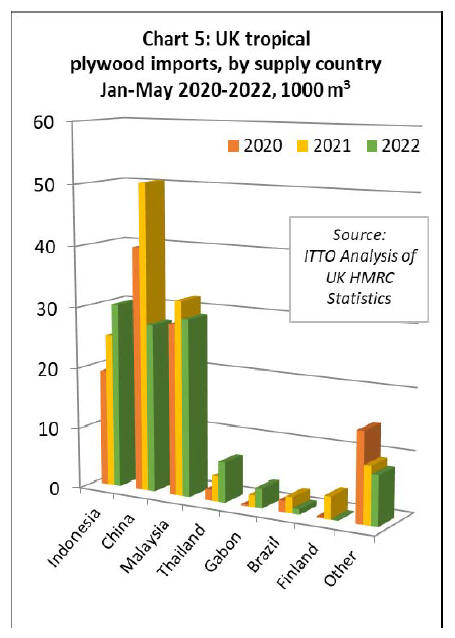
The UK imported 30,300 cu.m of tropical plywood from
Indonesia in the first five months of this year, a gain of
21% compared to the same period last year. Imports from
Indonesia, which were quite slow between February and
April this year, picked up pace again in May. The UK
imported 29,100 cu.m of plywood from Malaysia in the
first five months of this year, 9% less than the same period
last year. Imports from Malaysia also picked up in May to
their highest monthly level for over a year.
The UK imported 27,600 cu.m of tropical hardwood
plywood from China in the first five months of this year,
28% less than the same period in 2021, trade having been
affected by COVID lockdowns in China. At the same
time, Brexit is impacting on UK imports of tropical
hardwood plywood from EU countries which were just
5,200 cu.m in the opening five months of this year
compared to over 10,000 cu.m during the same period in
the last two years.
Strong rise in UK imports of tropical sawnwood
UK imports of tropical sawnwood started this year
strongly. Imports were 47,500 cu.m in the first five
months of 2022, 49% more than the same period last year.
In addition to making major gains overall, there were big
changes in the countries supplying tropical sawnwood to
the UK in the opening months of this year (Chart 6).
This is indicative of the major shifts in hardwood markets
since the start of the pandemic which have led to
significant supply shortages and sharply increasing prices
in many supply regions and continuing high levels of
demand in markets like the UK.
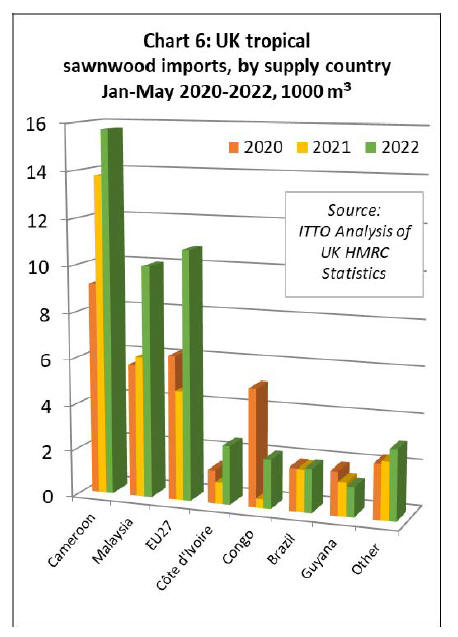
UK imports of tropical sawnwood from Cameroon were
15,700 m3 in the first five months of this year, 14% more
than the relatively high level in the same period last year.
UK imports from Malaysia, which had fallen to little more
than a trickle in recent years, were 10,000 cu.m in the first
five months of this year, 65% more than in the same
period last year.
UK imports of tropical sawnwood from Côte d'Ivoire were
2,500 m3 in the first five months of this year, a 170%
increase compared to negligible imports in the same
period last year. UK imports of tropical sawnwood from
the Republic of Congo (RoC) have also recovered some
lost ground this year, with imports of 2,100 cu.m in the
first five months, a 430% gain compared to the same
period last year, although still well down on the prepandemic
level.
UK imports of tropical sawnwood from Brazil were 1,900
cu.m in the first five months of this year, 3% more than
the same period last year and still down on the prepandemic
level.
After losing ground following Brexit and during the
pandemic, indirect UK imports of tropical sawnwood from
EU countries have been recovering again this year. Total
UK imports from EU countries were 10,800 cu.m in the
first five months of this year, up from just 4,800 m3 in the
same period in 2021.
UK imports of tropical hardwood mouldings/decking were
relatively high in the opening five months of 2022, at
5,600 tonnes, 67% more than the same period last year.
This is another commodity group for which there has been
particularly strong demand in the UK, combined with
sharply tightening supply since the start of the pandemic.
The war in Ukraine and sanctions on Russia are expected
to lead to even tighter supplies of non-tropical decking
products that directly compete with tropical decking in the
short to medium term.
UK imports of decking/mouldings increased sharply from
Indonesia, Malaysia and Brazil in the first five months of
this year. Imports of 2,000 tonnes from Indonesia were
86% more than the same period last year. Imports of 1,400
tonnes from Malaysia were 40% up on the same period in
2021. Imports from Brazil increased 93% to 1,200 tonnes
during the five month period. (Chart 7).
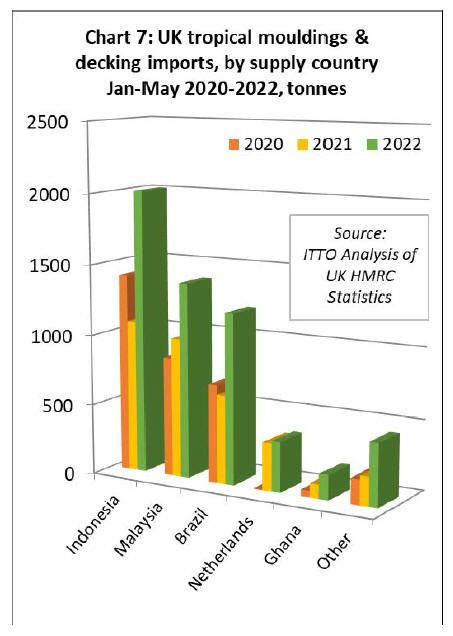
TDUK urges vigilance to ensure birch plywood
contains no Russian wood
TDUK has issued a trade alert urging vigilance to ensure
no plywood offered by Asian manufacturers to UK
importers contains birch originating in Russia.
TDUK note that UK sanctions introduced in response to
Russia¡¯s invasion of Ukraine prohibit the import,
acquisition, supply and delivery of revenue on all wood
products coming from Russia. This spans across all wood
categories but is particularly relevant to birch plywood as
significant volumes were exported to the UK prior to the
conflict.
The UK timber industry has responded to the Russia-
Ukraine conflict by significantly reducing imports across
all the main Russian import categories. However, TDUK
note that ¡°a worrying development has emerged in recent
weeks as TDUK members have reported increasing offers
of birch plywood coming from Asia, particularly China¡±.
The birch in this plywood is, according to TDUK, almost
certainly derived from Russia ¡°given that birch forests are
concentrated in Northern Russia¡± and that ¡°China does not
share the same view of the West regarding the Ukraine
conflict. This means China has imposed no sanctions on
Russia, with trade patterns continuing as they were prior to
the conflict¡±.
TDUK also suggest that ¡°the increasing isolation of the
Russian economy has provided a business opportunity for
many Chinese timber suppliers, with sanction-stricken
products such as Russian birch now becoming widely
available for import and processing¡±.
TDUK warn that ¡°despite the birch plywood being
processed in China, any timber originating from Russia is
now illegal to import into the UK or the EU. Any [TDUK]
member or non-member who imports birch plywood from
outside of the EU runs a high risk of being in breach of
UK sanctions¡±.
In response, TDUK are writing directly to manufacturers
offering to supply birch plywood from China and other
Asian countries making them aware of both UK and EU
sanctions. Additionally, TDUK is asking member
companies receiving offers of birch plywood to reply with
information on the sanctions applying in the UK and EU.
TDUK note that should Russian wood be found in the
UK/EU market ¡°the importer and all customers who have
purchased these products will be subject to legal action,
fines and reputational damage which would also impact
their trading partners in the manufacturing country¡±.
UKCA due to replace CE mark in UK from 1 January
2023
After the UK signalled its intention to leave the EU the
government set out plans to stop recognising the CE mark
and to introduce the UK Conformity Assessed (UKCA)
mark instead. For construction products this was originally
due to take place on 1 January 2022 but the deadline was
extended until 1 January 2023 due to the pandemic and
because there was a lack of available UK Approved
Conformity Assessment Bodies.
Like the CE mark, the UKCA mark indicates that a
product conforms with the applicable product safety
requirements for products of its type sold in Great Britain.
The UKCA mark shows that a product has been assessed
for conformity, with the results of that assessment being
summarised in the manufacturer¡¯s Declaration of
Performance.
Most construction products that are currently CE marked,
or new products covered by a UK Designated Standard,
will need to be UKCA marked from 1 January 2023. The
marks are required for structural timber and wood-based
panels for which there is a harmonised European standard
or UK Designated Standard. Wood-based products such
as skirting, architraves and other wood trim are not
covered by a harmonised standard and therefore do not
require CE marking.
Wood-based panels specifically designed for furniture are
not construction products and therefore do not typically
require marks. Other wood products not typically
requiring marks are general sawn or machined goods
(unless they are Structural or Flooring). Decking also, on
the whole, is exempt but may count as Structural if it is
used as a balcony or raised up on columns.
While the official deadline for introduction of the UKCA
mark requirement is 1 January 2023, the UK Construction
Products Association has warned government that unless
they take action to make the UKCA marking requirements
more flexible, many sectors could be left unable to place
products on the market after that date. This could result in
tradespeople being unable to purchase essential
construction materials, potentially delaying projects and
damaging the UK¡¯s economic growth.
It is possible that the deadline will be delayed again
following passage of the Building Safety Bill, which gives
Ministers the power to alter the date. The new law is
expected to be introduced during the next (Autumn 2022)
session of the UK parliament.
More information about the UKCA marking regulations is
available at:
https://www.gov.uk/guidance/using-the-ukca-marking
|